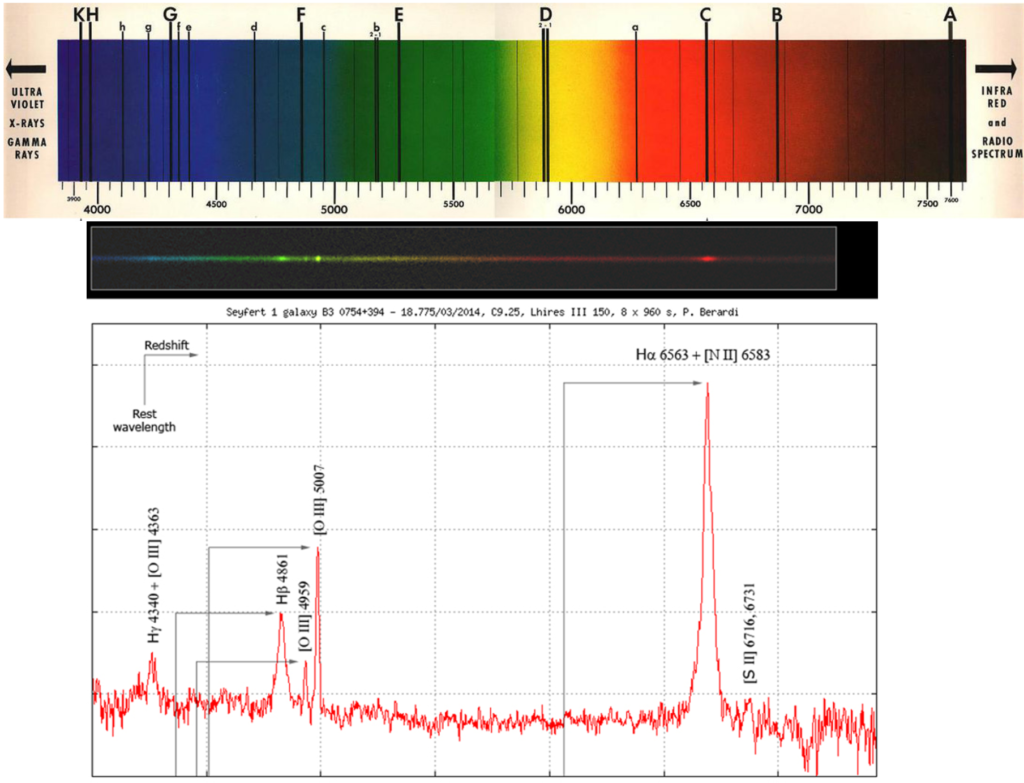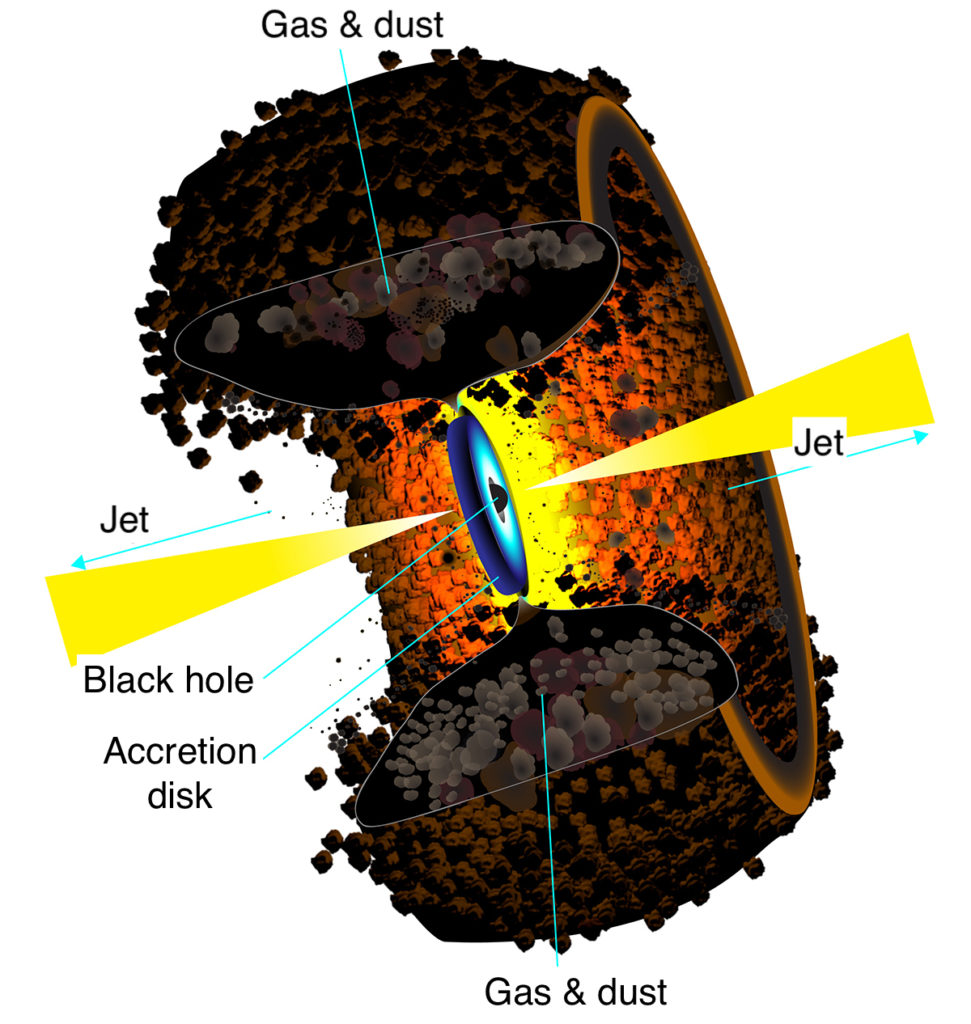
Hidden within the depths of a distant galaxy, a luminous behemoth lurks. As it greedily devours whole star systems, the leviathan unlooses a blistering spurt of flame light years long and crackling so loudly it can be heard across the Universe. Astronomers first discovered these cosmic monsters, called active galactic nuclei or AGN, during World War II. Even though they are some of the brightest objects in the Universe, clouds of dust and gas within their host galaxies obscure their machinations. Understanding the evolution of galaxies and the formation of planetary systems requires unveiling these cosmic monsters, and computer simulations coupled with JWST observations are helping unveil these cosmic monsters.

Speeding Rainbow
As many astronomical discoveries, AGN owe their detection to the advent of new science and technology. The emergence of spectroscopy in the early 1900s allowed astronomers to learn about the compositions and natures of across the Universe. The work of German scientists Fraunhofer and Kirchoff in the mid-1800s showed that hot atoms emit light at very specific colors, producing narrow spectral lines unique to each atom. This discovery allowed astronomers to determine the compositions of distant objects from their light alone. (In fact, helium was identified spectroscopically in the Sun before it was found on Earth). However, the physics behind spectra wasn’t understood until the 1920s, when quantum mechanics was invented.
By the 1940s, astronomers were applying quantum theory to interpret and predict cosmic spectra. But in 1943, astronomer Carl Seyfert published observations of nearby galaxies with very active nuclei with unusual spectra. Unlike the spectral lines of stars and laboratory gases, Seyfert’s spectral lines were very wide. These objects also seemed to produce enormous amounts of radio waves.
Astronomers puzzling over these wide spectral lines eventually settled on a simple but surprising explanation, Doppler broadening: the spectrally emitting gas must be moving at close to the speed of light, which meant an enormous gravitational field must be stirring the gas to very high speeds deep in the galaxies’ centers. Astronomers came to name these hotbeds of radiation “active galactic nuclei” or AGN.
Cosmic Blenders

As so often in astronomy, black holes were the culprit, in this case, supermassive black holes millions or billions of times the Sun’s mass. A black hole that massive warps spacetime on vast scales – from the center of our Solar System, the black hole in M87* could gobble up everything past Pluto.
Embedded at the heart of one of these galaxies, this gravity inexorably draws in anything that wanders too close, molding the material into an accretion disk, which orbits the black hole at near-lightspeed in ever-tightening spirals. Like an over-powered blender, the black hole’s gravity stirs the disk, heating it to atom-rending temperatures. And just before plunging into the black hole, some of this plasma is swept up in the black hole’s magnetic field, where, instead of falling in, it is launched into intergalactic space. Charged particles spiraling along magnetic field lines produce prodigious radio signals.
AGN jets can be so bright they can be seen from across the universe, but how bright an AGN looks to us on Earth depends on how it is oriented. If the jet points almost directly at Earth, the AGN is called a quasi-stellar object or “quasar”, the brightest objects in the Universe. If, instead, the jet points a little way from Earth, the gas and dust enshrouding the AGN may obscure the jet, only letting through radio waves. This is the kind of AGN that Seyfert first spotted.
AGN Revealed

This obscuration makes it hard for astronomers to accurately identify AGN, which is a problem if you want to understand how AGN and galaxies evolve over time. All galaxies may pass through an AGN phase during their youths but, over time, the AGN clears out all the material within and then shuts down when it runs out of food. Understanding that transition from ravening to quiescent is hard since the last stages, when the AGN is quieting down, are most likely to be obscured. AGN can disrupt and prevent the formation of stars and therefore planetary systems, so it’s crucial we understand how and when they calm down.
One way to lift the veil on AGN is to computationally model the obscuration and then do a little statistical geometry to work out how many AGN might remain hidden, and some recent studies suggest that as much as 50% of AGN may be significantly obscured. Another approach is to use observations that can peer through dust – that’s where JWST comes in. With its unprecedented abilities to see in infrared, JW is a dust-lifting machine. Already, JWST is peering through the darkness to probe the impact AGN have on star-forming regions in nearby galaxies. The figure above shows how different atomic spectral features, diagnostic of star-formation, appear to clump within the nearby galaxy NGC 7469 in places where star formation is thought to concentrate.
This interplay between astrophysical observation and theory will continue to shed light on these most destructive of cosmic monsters, helping to unravel the earliest, crucial phases in galactic evolution.
On Friday, Apr 7 at 7:30p MT, join Boise State Physics for our First Friday Astronomy event when we will host Dr. Christopher Carroll, who will discuss his research on obscured supermassive black holes within AGN. The event will be presented in-person on campus (room 112 in the Education Building) and via live-stream – http://boi.st/astrobroncoslive.